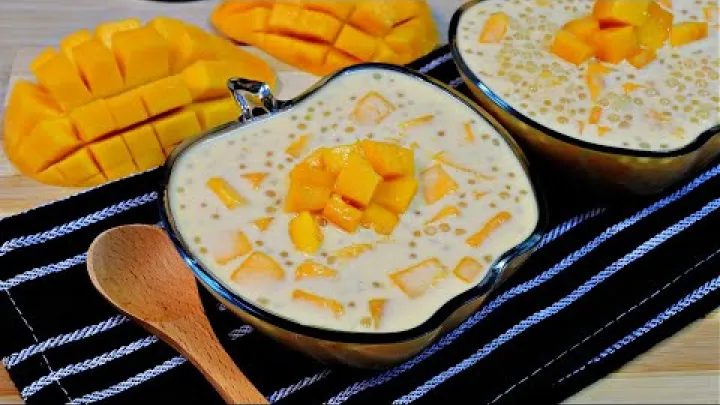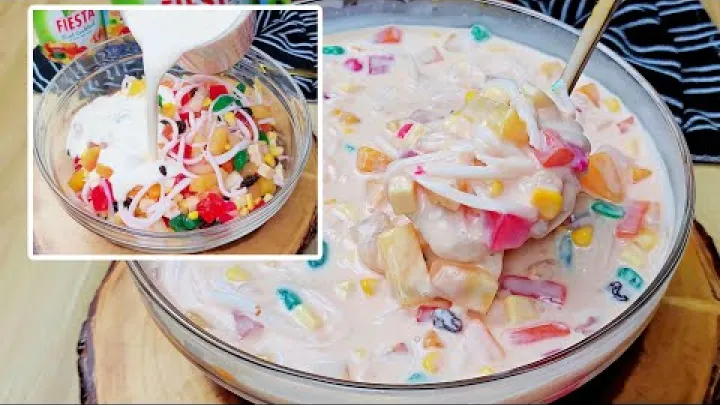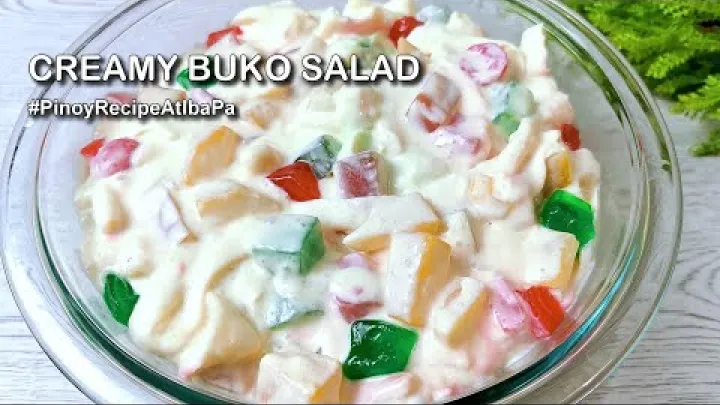Beat the Summer Heat: Taste the Best of Filipino Desserts
Halo-halo
One of the most popular desserts in the Philippines is Halo-halo, a unique blend of sweetened fruits, evaporated milk, and crushed ice. The dessert's name means "mixed," and it's a perfect representation of the country's mix of cultures and flavors. If you're a tourist in the Philippines, you should never leave without trying Halo-halo. It's a refreshing treat that's perfect for the country's hot and humid weather. In this post, we'll give you an introduction to the dessert, its history, and what makes it special.
Historical Background
The exact origins of halo-halo dessert are still unclear. But the dessert’s roots can be traced back to the Japanese dessert “Kakigori” or shaved ice, which was brought to the country by Japanese traders. The dessert eventually evolved, and Filipinos started adding their unique spin to it. The earliest version of Halo Halo had just 3 ingredients – boiled kidney beans, sugar palm, and caramelized plantain. But today, the dessert is a feast for the senses, with different variations made in every region using locally produced ingredients.
Ingredients and Preparation
Halo-halo dessert is made up of a base of shaved ice that’s topped with a variety of toppings and finished off with evaporated milk, sugar, and gelatin. The base of shaved ice is mixed with sweetened milk or condensed milk to add creaminess to the dish. The toppings of halo-halo can vary depending on where it’s made but usually include sweetened fruits like jackfruit, mango, and banana, tapioca pearls, sweet beans, sweet potato, and leche flan. Sometimes, it’s topped off with a scoop of ube (purple yam) ice cream that adds creaminess and richness to the dessert.
Health Benefits of Halo-halo Dessert
Although Halo Halo PH dessert is high in calories and sugar content, it does have some health benefits. The dessert contains a variety of sweet beans, which are low in calories, high in protein, and low in fat, and the fruits used in Halo Halo are berry-shaped and contain antioxidants that can reduce inflammation and lower the risk of certain diseases. To make Halo Halo healthier, you can reduce the sugar or syrup used and use less sweetened milk while building the dish.
Buko Pandan
When it comes to Filipino desserts, one can't help but be drawn to its unique flavors and textures that are guaranteed to leave you craving for more. One such dessert is buko pandan, a popular Filipino sweet dish that is made with young coconut meat and Pandan-flavored jelly. It is a treat that is loved by Filipinos and has become a staple in Filipino homes during celebrations and gatherings, and it’s also a must-try for tourists visiting the Philippines. In this post, we’ll take a closer look at this sweet treat and why it's so highly regarded by Filipinos.
How Is It Made?
Buko pandan is a dessert that is popular all over the Philippines. It's made by combining freshly grated young coconut meat, which is naturally sweet, with Pandan-flavored jelly, which gives the dessert its unique green color. This delicacy is typically served cold, and it’s topped with evaporated milk and sugar for added sweetness.
What Makes It Unique?
What makes this dessert so special is its distinct flavor and texture. The unique combination of creamy coconut meat and chewy Pandan-flavored jelly creates a unique texture that is both refreshing and satisfying. Its subtle flavor profile that leans towards being mildly sweet and nutty is what makes it an ideal dessert for those who don't want their sweets to overpower their taste buds.
Where To Try It?
If you want to try this delicious treat, you can easily find it in most Filipino restaurants and bakeries, where it’s often sold in takeaway portions. However, one of the best places to try buko pandan is during Filipino celebrations and festivities where it’s commonly served alongside other traditional dishes and desserts. When it comes to making buko pandan at home, it's surprisingly easy to get started. You can find many recipes online, and most of the ingredients can be found in Asian grocery stores or even your local grocery store. The preparation time is short, and the result is a sweet and refreshing dessert that will surely impress your guests.
Mais Con Yelo
The Philippines is known for its delectable and diverse cuisine, and one of the popular sweet treats that you must try is mais con yelo. This refreshing dessert is perfect for those who have a sweet tooth and want to cool down on hot sunny days. Mais Con Yelo is a simple yet flavorful dessert that you can easily make at home or order from various food establishments. In this blog, we will give you an overview of what mais con yelo is, its history, and how you can make this dessert yourself.
What Is It
Mais con yelo, also known as mais con hielo, is a popular cold dessert in the Philippines. The translation of “mais con yelo” is “corn with ice.” This dessert consists of sweetcorn kernels submerged in crushed or shaved ice, mixed with condensed or evaporated milk and sugar. It is then topped with scoops of vanilla ice cream and a sprinkle of toasted pinipig, a local delicacy made from pounded and toasted glutinous rice grains. Some variations of mais con yelo include adding extra ingredients such as sweetened beans, kaong (palm fruit), nata de coco (sweet gelatin-like cubes derived from coconut water), and even cheese.
How To Make It
To make your own homemade mais con yelo, you will need the following ingredients: sweetcorn kernels, crushed ice or shaved ice, condensed or evaporated milk, sugar, vanilla ice cream, and toasted pinipig. The steps to make mais con yelo are simple and easy. Start by boiling the sweetcorn kernels in water until they are tender. Drain and set aside. In a bowl, mix condensed milk, sugar, and a small amount of water until well combined. Add the cooked sweetcorn kernels and stir. Place crushed or shaved ice in a goblet or tall glass, then add the sweetcorn mixture on top. Add scoops of vanilla ice cream and sprinkle with toasted pinipig. Serve and enjoy the refreshing dessert!
Its Unique Feature
One unique feature of mais con yelo is its ability to be a social dessert. It's commonly served during Filipino gatherings like birthdays, reunions, or fiestas. In those events, the shaved ice and corn kernel mixture is placed in a bowl, and the guests can top it off with their desired ingredients. Friends and families gather around the bowl, sharing stories and laughter while enjoying the refreshing dessert. It's an integral part of Filipino hospitality, as it represents the joy and unity that food can bring.
Leche Flan
When it comes to desserts, Filipinos certainly know how to indulge their sweet tooth. From classic rice cakes to fruity desserts, the Philippines has a lot to offer in terms of sweet treats. But perhaps the most popular and beloved Philippine dessert is leche flan. This rich and creamy custard is a staple in Filipino households, especially during special occasions. In this blog, we'll dive into the history, ingredients, and preparation of leche flan and explore why it's such a beloved treat in the Philippines.
How It Originated
Leche flan, also known as caramel custard, is a dessert that dates back to colonial-era Philippines. It's believed that its origins can be traced back to Spain, where flan is a popular dessert. The word "leche" means milk in Spanish, and this dessert was originally made with condensed milk, egg yolks, and sugar. Today, leche flan is still made with these traditional ingredients, but many cooks add their twists and ingredients. Some add cream or evaporated milk for a creamier texture, while others infuse it with vanilla or citrus flavors. Whatever the variation, leche flan remains a beloved dessert across the Philippines.
Steps In Making A Leche Flan
To make leche flan, egg yolks are whisked with condensed milk, evaporated milk, and sugar until they're combined. The mixture is then poured into a mold coated with caramel sauce, which is made by heating sugar and water until it turns golden brown. The mold is then steamed until the custard is set. The result is a sweet, silky-smooth custard infused with a caramel flavor.
Perfect For Social Gatherings
Aside from its delicious taste, leche flan has also become a symbolic dessert in the Philippines. Many Filipinos associate it with special occasions, such as Christmas and Easter. It's often served at family gatherings and potlucks, and it's not uncommon for Filipinos to exchange leche flan as a gift during the holiday season. Because of its popularity, many bakeries, restaurants, and dessert shops across the Philippines now offer their take on leche flan, each with its unique twist.
Mango Tapioca
A trip to the Philippines is incomplete without tasting its famous desserts, and one that stands out is the beloved mango tapioca. This sweet and creamy treat is a perfect blend of sweet and sour and is a favorite among locals and tourists. The Philippines is known for its abundance of tropical fruits, and mangoes are one of the most popular. When combined with tapioca pearls and coconut milk, they create a delightful dessert that will leave you craving more.
How It Is Usually Served
The mango tapioca dish is an easy-to-make dessert originating from Southeast Asia, made with cooked tapioca pearls, fresh mangoes, condensed milk, and coconut milk. The dessert is traditionally served in small glasses with lightly sweetened tapioca pearls, creamy coconut milk, and a refreshing mango puree. Preparing the dessert is quite simple, and you can easily make it at home. The tapioca pearls are boiled until they become transparent and added to a mixture of coconut milk and condensed milk. Then, the cubed mango pieces are mixed in and chilled to perfection. The dessert is topped with crushed ice, and the presentation is completed with a drizzle of mango puree.
Perfect Dessert For Summer
The dish is incredibly refreshing and perfect for a hot day. It's not too sweet, making it an excellent dessert for anyone trying to avoid too much sugar. The cooling sensation you get from the dessert combined with the sweetness of the mangoes will leave you feeling satisfied yet still wanting more. While the dessert is widely available in the Philippines through local dessert stores and street vendors, making it at home is just as rewarding.
Its Heath Benefits
Mango tapioca is not only a delicious dessert but it's also a healthy one too. Mangoes, the main ingredient of the dish, are rich in vitamins C and A and are known for their anti-inflammatory and antioxidant properties. Tapioca pearls are gluten-free and can help in digestion. With their chewy texture and colorless appearance, tapioca pearls are a fun ingredient to experiment with when making desserts, especially if you're looking for gluten-free options.
Mango Float
If you are a tourist looking for new and exciting treats to try, then you should indulge in the deliciousness of mango float. This dessert is a classic Filipino recipe that has become a favorite among locals and visitors alike. It is easy to make and can be enjoyed anytime, anywhere. In this post, we'll be taking a closer look at this creamy and sweet dessert that is sure to delight your taste buds.
Its Main Ingredients
The main ingredients of mango float are graham crackers, cream, sweetened condensed milk, and mango. Graham crackers are layered alternately with the cream mixture and mango slices. The cream mixture is made up of cream, sweetened condensed milk, and vanilla extract. All these ingredients work together to create a smooth and velvety texture and the perfect balance of sweetness and tanginess.
How To Prepare It
Preparing mango float is easy and simple. Start by preparing the cream mixture and slicing the mangoes into thin strips. Then, in a rectangular baking dish, lay the graham crackers at the bottom. Next, spread a generous amount of cream mixture and add a layer of mango slices. Repeat the process of layering until you reach the desired height of the dessert. Lastly, chill the dessert in the fridge overnight. The longer the dessert is refrigerated, the softer the graham crackers become, and the tastier Mango Float becomes.
It's Very Refreshing
Mango float can be enjoyed on any occasion, big or small. It's a dessert that pleases not only your sweet tooth but also your eyes. The yellow tint from the mangoes contrasting with the white cream mixture gives off a vibrant and fresh look. Having a slice of mango float after a hearty meal is the perfect way to end your day. It's light, refreshing, and not too heavy on the stomach.
Silvanas
If you are planning to visit the Philippines, you must not miss the chance to indulge in one of its most famous desserts called silvanas. This scrumptious Filipino delicacy is a mouthwatering treat that is loved by both locals and tourists alike. If you have a sweet tooth and are looking for an unforgettable culinary experience, then silvanas is a must-try dessert.
Where It Originated
Silvanas is a type of cookie that originated in Dumaguete, a city in the southern part of the Philippines. These rich and buttery cookies consist of two layers of cashew-meringue wafers with a creamy buttercream filling in between. The cookies are then coated with cookie crumbs that give it a crunchy texture. The combination of nutty and creamy flavors, along with the flaky consistency, make this dessert a popular choice among Filipinos.
Where To Try It
One of the best places to try this delicious dessert is the famous Sans Rival Cakes and Pastries in Dumaguete City. This bakery specializes in making silvanas and has been doing so for almost 50 years. Their version of silvanas is highly recommended by locals and tourists who have visited the bakery. The bakery also has a wide variety of other pastries that you can enjoy along with your silvanas.
What Makes It Unique
What makes Silvanas unique is the combination of textures and flavors. The meringue wafer is crunchy and nutty, while the buttercream filling is smooth and creamy, with just the right sweetness. Adding to the delectable experience is the coating of cookie crumbs that provide an extra layer of flavor and texture. Silvanas is best enjoyed as a dessert or snack, paired with chocolate.
Filipino Fruit Salad
As a tourist coming to the Philippines, you are in for an exciting culinary journey. One of the desserts you shouldn't miss is the Filipino fruit salad. This dessert is known for its sweet and creamy flavor, which makes it perfect for any occasion. Filipino fruit salad is a combination of different fruits, typically mixed with condensed milk and all-purpose cream. It's a must-try dessert that will surely satisfy your cravings for something sweet and refreshing, especially during the hot and humid Philippine weather. In this blog, we'll explore the different ingredients used in making this delicious dessert and the recipe for making it yourself.
The Ingredients
The ingredients used in making Filipino fruit salad are diverse and can vary depending on the preference of the cook. The most common fruits used are canned fruit cocktails, canned peaches, canned pineapples, and fresh fruits such as apples, mangoes, and bananas. You can also add other fruits such as kiwi, grapes, and strawberries for extra flavor and texture. The use of a canned fruit cocktail is popular because it provides a mixture of different fruits in one can, making it easy to prepare.
Steps In Making It
To make the Filipino fruit salad dessert, start by mixing all the fruits in a large bowl. Add in the condensed milk and all-purpose cream and mix well. It's important to chill the dessert for at least an hour or two before serving to allow the flavors to blend and the cream to thicken. You can also add sliced cheese or nata de coco, which is a chewy jelly-like substance made from coconut water or coconut milk extract, to add an extra twist to the dessert.
Another Variation
Another variation of Filipino fruit salad is the buko salad. This dessert is made with young coconut meat mixed with fruits, sweetened milk, and cream. It's a refreshing and healthy dessert that is perfect for summertime. The preparation for this dessert involves scraping the meat from the coconut and washing it with cool water. The coconut meat is then mixed with the fruits, sweetened milk, and all-purpose cream. It's best served chilled for a cool and refreshing dessert.
Conclusion
Filipinos are known for their love of food and desserts. During the hot and humid summers, there are several traditional Filipino desserts that you can enjoy to beat the heat. From silvanas to fruit salads, these desserts will surely satisfy your cravings for something sweet and refreshing. So if you're looking for something different to try this summer, try one of the top summer desserts in the Philippines. You'll be sure to enjoy these amazing treats!
Your Nearby Location
Your Favorite
Post content
All posting is Free of charge and registration is Not required.









